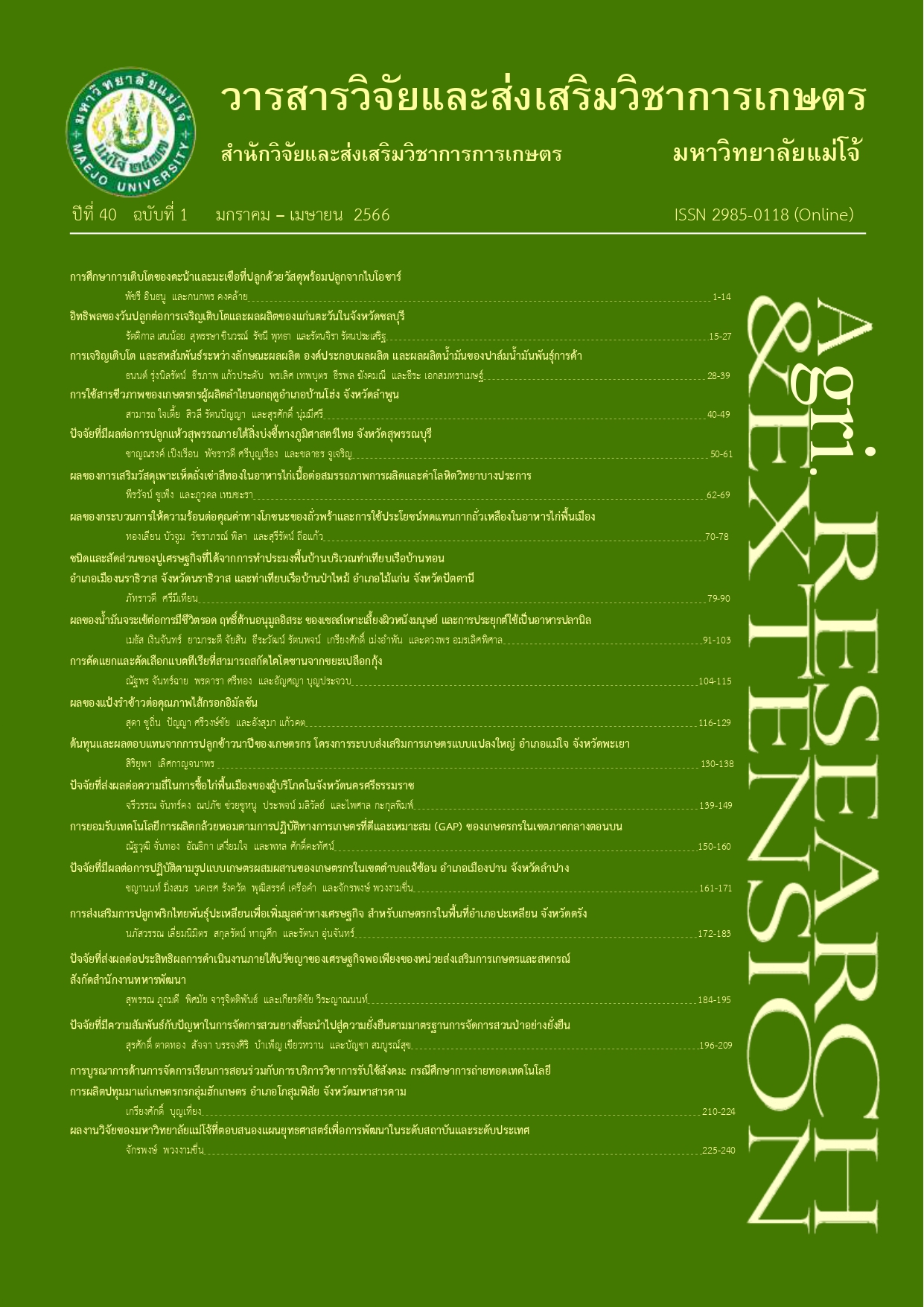ผลของน้ำมันจระเข้ต่อการมีชีวิตรอด ฤทธิ์ต้านอนุมูลอิสระ ของเซลล์เพาะเลี้ยงผิวหนังมนุษย์ และการประยุกต์ใช้เป็นอาหารปลานิล
คำสำคัญ:
น้ำมันจระเข้, การมีชีวิตรอดของเซลล์ , ฤทธิ์ต้านอนุมูลอิสระ , อาหารปลา , ประสิทธิภาพการเติบโตบทคัดย่อ
ไขมันจระเข้จากฟาร์มวิสาหกิจชุมชนถูกนำมาสกัดเป็นน้ำมัน นำน้ำมันจระเข้ไปทดสอบความมีชีวิตรอด ฤทธิ์ต้านอนุมูลอิสระในเซลล์เพาะเลี้ยงผิวหนังของมนุษย์ (Human keratinocyte line; HaCaT cell) และประเมินการเจริญเติบโตของปลานิลที่ได้รับน้ำมันจระเข้ จากผลการศึกษาพบว่า น้ำมันจระเข้มีองค์ประกอบของกรดไขมันไม่อิ่มตัว 71.26 กรัม/100 กรัม และมีสัดส่วนของกรดไขมันโอเมก้า 3, 6 และ 9 เท่ากับ 1.67, 24.53 และ 39.71 กรัม/100 กรัม ตามลำดับ การศึกษาใน HaCaT cell พบว่าน้ำมันจระเข้ที่ละลายใน Tween 20 ในขนาด 0.125 และ 0.25% ไม่มีความเป็นพิษต่อเซลล์ ช่วยเพิ่มการมีชีวิตรอดของเซลล์ที่ถูกทำลายด้วยรังสียูวีบี (UVB) และมีฤทธิ์ต้านอนุมูลอิสระโดยลดการสร้างอนุมูล NO ที่ถูกกระตุ้นด้วย UVB ในเซลล์เพาะเลี้ยงได้ จากนั้นน้ำมันจระเข้ถูกไปประยุกต์ใช้ในอาหารเลี้ยงปลานิลเป็นเวลา 4 เดือน พบว่าน้ำมันจระเข้ระดับ 4% สามารถนำมาใช้เป็นส่วนผสมในอาหารปลา และเพิ่มประสิทธิภาพการเจริญเติบโตของปลานิลได้ อย่างไรก็ตามต้องมีการศึกษาเพิ่มเติมทางเภสัชวิทยาของน้ำมันจระเข้เพื่อการใช้ประโยชน์เชิงพาณิชย์ต่อไป
เอกสารอ้างอิง
Buthelezi, S., C. Southway, U. Govinden, J. Bodenstein and K. du Toit. 2012. An investigation of the antimicrobial and anti-inflammatory activities of crocodile oil. Journal of Ethnopharmacology 143(1): 325-330.
Chaeychomsri, W., S. Chaeychomsri, J. Siruntawineti, D. Hengsawadi and Y. Cuptapun. 2009. Freeze-dried crocodile blood production as food supplement. Journal of Bioscience and Bioengineering 108(S1): S22.
Jaisin, Y., P. Ratanachamnong, O. Wongsawatkul, A. Watthammawut, K. Malaniyom and S. Natewong. 2020. Antioxidant and anti-inflammatory effects of piperine on UV-B-irradiated human HaCaT keratinocyte cells. Life Science 263: 1-9.
Li, H.L., Y.T. Deng, Z.R. Zhang, Q.R. Fu, Y.H. Zheng, X.M. Cao, J. Nie, L.W. Fu, L.P. Chen, Y.X. Xiong, D.Y. Shen and Q.X. Chen. 2017. Evaluation of effectiveness in a novel wound healing ointment-crocodile oil burn ointment. African Journal of Traditional, Complementary and Alternative Medicines 14(1): 62-72.
Ngernjan, M., A. Ontawong, N. Lailerd, K. Mengamphan, S. Sarapirom, and D. Amornlerdpison. 2022. Crocodile oil modulates inflammation and immune responses in LPS-stimulated RAW 264.7 macrophages. Molecules 27(12): 3784. DOI: 10.3390/molecules27123784.
Praduptong A., J. Siruntawineti, S. Chaeychomsri, P. Srimangkornkaew and W. Chaeychomsri. 2018. Acute oral toxicity testing of siamese crocodile (Crocodylus siamensis) oil in wistar rats. Bioscience Discovery 9(3): 409-15.
Rattanaphot, T., K. Mengumphan, S. Tongsiri, C. Srimaroeng and D. Amornlerdpison. 2018. Enhancement of oxidative defence and growth performance of Nile tilapia by omega-9-rich freshwater fish oil. Maejo International Journal of Science and Technology 12(1): 79-88.
Salucci, S., S. Burattini, F. Buontempo, A.M. Martelli, E. Falcieri and M. Battistelli. 2017. Protective effect of different antioxidant agents in UVB-irradiated keratinocytes. European Journal of Histochemistry 61(3): 2784 [Online]. Available https://doi.org/10.4081/ejh.2017.2784 (November 11, 2021).
Shim-Prydon, G. and H. Camacho-Barreto. 2007. New Animal Products: New Uses and Markets for By-products and Co-products of Crocodile, Emu, Goat, Kangaroo and Rabbit. 65 p. A Report for the Rural Industries Research and Development Corporation, March 2007 RIRDC Publication no. 06/117. Deakin West: Rural Industries Research and Development Corporation.
Siddiqui, R., S. Jeyamogan, S.M. Ali, F. Abbas, K.A. Sagathevan and N.A. Khan. 2017. Crocodiles and alligators: antiamoebic and antitumor compounds of crocodiles. Experimental Parasitology 183: 194-200.
Turnage, R.H., F. Nwariaku, J. Murphy, C. Schulman, K. Wright and H. Yin. 2002. Mechanisms of pulmonary microvascular dysfunction during severe burn injury. World Journal of Surgery 26(7): 848.
Wu, S., L. Wang, A.M. Jacoby, K. Jasinski, R. Kubant and T. Malinski. 2010. Ultraviolet B light‐induced nitric oxide/peroxynitrite imbalance in keratinocytes-implications for apoptosis and necrosis. Photochemistry and Photobiology 86(2): 389-396.
ดาวน์โหลด
เผยแพร่แล้ว
รูปแบบการอ้างอิง
ฉบับ
ประเภทบทความ
สัญญาอนุญาต
ลิขสิทธิ์ (c) 2023 วารสารวิจัยและส่งเสริมวิชาการเกษตร

อนุญาตภายใต้เงื่อนไข Creative Commons Attribution-NonCommercial-NoDerivatives 4.0 International License.
บทความนี้ได้รับการเผยแพร่ภายใต้สัญญาอนุญาต Creative Commons Attribution-NonCommercial-NoDerivatives 4.0 International (CC BY-NC-ND 4.0) ซึ่งอนุญาตให้ผู้อื่นสามารถแชร์บทความได้โดยให้เครดิตผู้เขียนและห้ามนำไปใช้เพื่อการค้าหรือดัดแปลง หากต้องการใช้งานซ้ำในลักษณะอื่น ๆ หรือการเผยแพร่ซ้ำ จำเป็นต้องได้รับอนุญาตจากวารสาร





